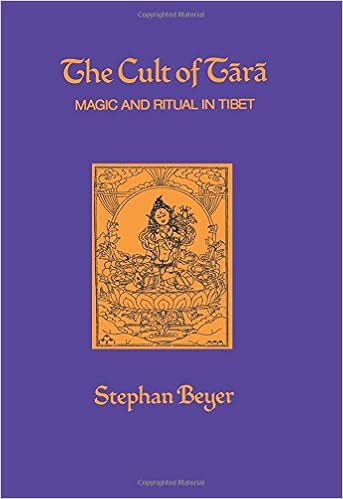Buddhism: Tibetan: Practices

This book reads a single Tibetan Buddhist ritual system through the movements of Tibetan history, revealing the social and material dimensions of an ostensibly timeless tradition. By subjecting tantric practice to historical analysis, the book offers new insight into the origins of Tibetan Buddhism, the formation of its canons, the emergence of new lineages and ceremonies, and modern efforts to revitalize the religion by returning to its mythic origins. The ritual system explored in this volume is based on the Gathering of Intentions Sutra, the fundamental "root tantra" of the Anuyoga class of teachings belonging to the Nyingma ("Ancient") school of Tibetan Buddhism. Proceeding chronologically from the ninth century to the present, each chapter features a Tibetan author negotiating a perceived gap between the original root text and the lived religious or political concerns of his day. These ongoing tensions underscore the significance of Tibet's elaborate esoteric ritual systems, which have persisted for centuries, evolving in response to historical conditions.
Koichi Shinohara traces the evolution of Esoteric Buddhist rituals from the simple recitation of spells in the fifth century to complex systems involving image worship, mandala initiation, and visualization practices in the ninth century. He presents an important new reading of a seventh-century Chinese text called the Collected Dharani Sutras, which shows how earlier rituals for specific deities were synthesized into a general Esoteric initiation ceremony and how, for the first time, the notion of an Esoteric Buddhist pantheon emerged. In these sutras, rituals for specific deities were typically performed around images of the deities, yet Esoteric Buddhist rituals in earlier sources involved the recitation of spells rather than the use of images. The first part of this study explores how such simpler rituals came to be associated with the images of specific deities and ultimately gave rise to the general Esoteric initiation ceremony described in the crucial example of the All-Gathering mandala ritual in the Collected Dharani Sutras. The visualization practices so important to later Esoteric Buddhist rituals were absent from this ceremony, and their introduction would fundamentally change Esoteric Buddhist practice.
 Introduction to Tantra: The Transformation of Desire by Lama Yeshe, edited by Jonathan Landaw. 2014.
Introduction to Tantra: The Transformation of Desire by Lama Yeshe, edited by Jonathan Landaw. 2014.
What is tantra? Who is qualified to practice it? How should it be practiced? What are the results? According to Buddhism, every human being has the potential to achieve profound and lasting happiness. And according to the tantric teachings of Buddhism, this remarkable transformation can be realized very quickly if we utilize all aspects of our human energy----especially the energy of our desires. This book is the best available clarification of a subject that is often misunderstood. Tantra recognizes that the powerful energy aroused by our desire is an indispensable resource for the spiritual path. It is precisely because our lives are so inseparably linked with desire that we must make use of desire's tremendous energy not just for pleasure, but to transform our lives. Lama Yeshe presents tantra as a practice leading to joy and self-discovery, with a vision of reality that is simple, clear, and relevant to 21st-century life.
Yoga, tantra and other forms of Asian meditation are practised in modernized forms throughout the world today, but most introductions to Hinduism or Buddhism tell only part of the story of how they developed. This book is an interpretation of the history of Indic religions up to around 1200 CE, with particular focus on the development of yogic and tantric traditions. It assesses how much we really know about this period, and asks what sense we can make of the evolution of yogic and tantric practices, which were to become such central and important features of the Indic religious scene. Its originality lies in seeking to understand these traditions in terms of the total social and religious context of South Asian society during this period, including the religious practices of the general population with their close engagement with family, gender, economic life and other pragmatic concerns.
The Instructions on the Six Lamps is a profound and important work from the Bön Dzogchen tradition and is one of the root texts of the Zhangzhung Nyengyü (Oral Transmission of Zhangzhung) series of orally transmitted teachings. Considered to be the central work of the inner cycle of these teachings, it expertly details the principles of the natural state and its visionary marvels. The root text describes highly secret precepts of Dzogchen (Great Perfection) practice—the teachings of Trekchö and Thögel—as revealed by Tapihritsa to Gyerpung Nangzher Löpo. The teachings in this text represent oral instructions transmitted by a single master to a single disciple in the mode known as “single transmission.” It is through such a practice that one can see the clear light of one’s own mind before achieving complete buddhahood. In this respect, the text contains a complete teaching of Dzogchen, from beginning to end.
The mind-training practices contained in the Dzogchen tradition of Tibetan Buddhism have never before been presented in the English language. The main text translated here, The Steps to Liberation, will be of great interest to Western practitioners, since its instructions are pithy and direct, and experiential rather than scholarly. The contemplations on core Buddhist principles like impermanence and karma, intended for beginning meditators, unfold as dramatic stories in which the meditator is to vividly imagine himself or herself as the main character who undergoes a sequence of experiences that result in transformative realizations. They distill the most essential teachings of the Buddha into a practical system that can be easily implemented in a daily meditation practice. At the same time, they bring together the most foundational Buddhist teachings with the profound methods of the Vajrayana (the esoteric teachings of Buddhist tantra). This is the hallmark of Dzogchen mind training and what sets it apart from other mind-training lineages.
Blending contemporary and traditional perspectives, this groundbreaking work offers guidance on the profound foundational practices of the Great Perfection. It contains classic commentaries by the renowned Tibetan masters Jigme Lingpa and Jamyang Khyentse Wangpo, alongside a lively contemporary discussion by filmmaker, author, and spiritual teacher Dzongsar Jamyang Khyentse that discusses how to incorporate these ancient practices into the fast-paced lifestyle of the Western world. Also included are a lengthy introduction to the world of Tibetan Buddhism and its meditative practices, as well as the long and short preliminary practice liturgies and numerous appendices on the nine yanas and other topics. The ngöndro or preliminary practice is treasured in the Ancient School of Tibetan Buddhism as vital for effecting a profound inner transformation and as a foundation for the very highest teachings of the Great Perfection, or Dzogchen. In particular, the Longchen Nyingtik ngöndro has long been cherished by followers of all traditions on account of its power, depth, and poetic beauty.
An illuminating look at key aspects of Tibetan Buddhist practice--of interest to many practitioners--is presented in this practical and interesting book. Through demonstrating the interrelationship of the outer inner and secret teachings and a textual analysis of the words of four renowned Dzogchen yogis, it makes clear that the practice of Bodhichitta is a necessary aspect of every practice within Tibetan Buddhism.Unlike other books that present either the teachings of Bodhichitta or the teachings of Dzogchen as their own system of practice, this book presents them not as complementary practices but as a deconstructed inner and outer practices which are fundamentally intertwined. Anyen Rinpoche works to create a new generation of holistic practitioners who value the depth found in the entire spectrum of teachings. While Anyen Rinpoche acknowledges the profundity of the Dzogchen teachings, he dispels the myth that they are an effortless path to liberation and rather shows that they are a progressive path that requires diligence, insight, and compassion.

One of the most beloved and oft-recited prayers in the Kagyu tradition of Tibetan Buddhism, The Mahamudra Lineage Prayer combines a supplication to the Mahamudra lineage with a concise guide to Mahamudra practice and the stages of the path to enlightenment. In this commentary on the prayer, Thrangu Rinpoche teaches in his down-to earth yet direct manner the importance of the Mahamudra lineage, how to develop renunciation and devotion through the common and uncommon preliminary practices, and how to practice calm abiding (Shamatha) and insight (Vipashyana) meditation in the Mahamudra tradition. He explains that Mahamudra teachings are easy to practice yet are very powerful, and are especially appropriate for serious Western Dharma students.
This guidebook for cultivating the meditative practices of stability and insight—the first major work from the Drukpa Kagyu lineage to become available in English—stands out among works of its kind as one of the clearest and most comprehensive presentations of coemergence, or mahamudra. In it, the eighteenth-century Tibetan master Ngawang Kunga Tenzin, the Third Khamtrul Rinpoche, details a step-by-step program of spiritual exercises that bring the meditator directly to clear realization of the fully perfect, ever-present, nondual nature of mind. Beginning with the close relationship between phenomena and mind and the immense benefits of meditating on the nature of mind, the Third Khamtrul Rinpoche offers careful instructions on the four yogas of mahamudra together with advice on how to recognize genuine progress and how to remove obstacles that arise during meditation. Characteristic of the Drukpa Kagyu approach is that, even from the earliest stages of training, the author explains how all experience, thoughts, and perceptions may be used as the path to enlightenment from the perspective of insight into the nature of mind.
Many books have been published in recent years on the topic of mahamudra, or meditation on the fundamentally clear nature of the mind. This book is different in the systematic way it draws from a variety of source texts in order to construct a complete, graded path of practice informed by an understanding of the particular obstacles faced by meditators in the West. This book offers a spiritual manual that describes the Tibetan Buddhist meditation known as mahamudra from the perspective of the 'gradual path.' The gradual path is a progressive process of training that is often contrasted to sudden realization. As such, this book contains a step-by-step description of the ways to practice, precise descriptions of the various stages and their intended realizations, and the typical problems that arise along with their remedies. Simply put, mahamudra meditation involves penetrative focus, free of conceptual elaboration, upon the very nature of conscious awareness. A unique feature of this book is its integrative approach to the stages of mahamudra meditation.
Mahamudra and Dzogchen are perhaps the most profound teachings within all of Tibetan Buddhism. The experience of Mahamudra, or "great symbol," is an overwhelming sense of extraordinary clarity, totally open and nondualistic. Dzogchen, or "great perfection," is the ultimate teaching according to the Nyingma tradition and also represents the pinnacle of spiritual development. These are the two paths that provide practitioners with the most skillful means to experience the fully awakened state and directly taste the reality of our mind and environment. And yet these concepts are notoriously difficult to grasp and challenging to explain. In this book, Tibetan Buddhist master Dzogchen Ponlop Rinpoche presents these esoteric teachings in a style that reveals their surprising simplicity and great practical value, emphasizing that we can all experience our world more directly, with responsibility, freedom, and confidence. With a straightforward approach and informal style, he presents these essential teachings in a way that even those very new to Tibetan Buddhism can understand.































































